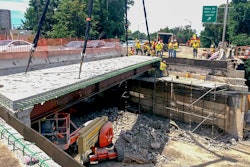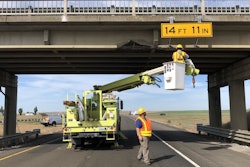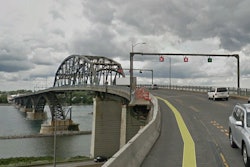 Work begins on the replacement of the Coplay-Northampton Bridge in 2017. Credit: Northampton County Bridge Division
Work begins on the replacement of the Coplay-Northampton Bridge in 2017. Credit: Northampton County Bridge DivisionA historic bridge’s replacement in Pennsylvania will be the country’s first project to use an electrically isolated tendon system (EIT), which provides a more efficient way to detect corrosion on post-tension tendons.
EIT technology has been used in Europe, and has its first U.S. introduction on the replacement of a 1930’s era bridge between Lehigh and Northampton Counties. The bridge is scheduled to be completed in 2020 at a cost of $33.5 million, according to Northeast Prestressed Products (NPP). NPP manufactured the prestressed beams for the project. The EIT technology can monitor for breeches in the corrosion protection system and can also be used for quality control during construction.
The Federal Highway Administration had been searching for a project to demonstrate EIT and worked with the Pennsylvania Department of Transportation on selecting the Coplay-Northampton Bridge owned by Lehigh County. Work on the demolition and rebuilding of the bridge began in 2017. Lehigh University’s Department of Civil and Environmental Engineering and Dywidag Systems International have also been involved with the project and will monitor it to determine EIT’s effectiveness. The project’s architect and engineer is AECOM; the contractor is Trumball Corporation.
The completed structure will be a three-span continuous bridge with pre-stressed bulb tee girders and four splices along the span, according to NPP. Five girder lines will be post-tensioned and grouted with four tendons per line, NPP says. A composite cast-in-place concrete deck will be added.
EIT can monitor the corrosion-protection system for the tendons. The high-strength steel tendons are encapsulated in a tight polymer duct and grouting. The anchor head is electrically isolated from the ground and the bridge’s reinforcement structure and prevents stray currents from affecting the tendons. The condition of the duct can be monitored throughout the steel’s life with electrical impedance measurements, according to NPP.
Electrical impedance is the measure of the opposition that a circuit presents to a current when a voltage is applied. This allows for checking the tendons’ conditions without having to tamper with the structure. An electrical terminal is pulled out of the anchorage for measuring impedance.
A demo of the EIT system for the project reportedly led to minimal changes to current construction practices.
“The use of the demo EIT technology did not have an adverse effect on the project schedule or budget,” says Larry Franko, project manager with Pennoni Associates, which is the construction manager and inspector for the bridge replacement. “I predict in the future this technology should be considered for every pre-stressed and post-tensioned project.”














